Our Plan
A five-year plan to make cogeneration a compelling alternative to age segregation
The problem
America today is the most age-diverse society in human history, with a quarter of the population under 20, a quarter over 60, and the rest in between.
At the same time, we’re arguably the most age-segregated nation in history.
This separation of generations is linked to a raft of problems, including generational conflict, rampant ageism, and an epidemic of loneliness and isolation, with older and younger people the two most isolated groups in society.
The mismatch between historic age diversity and the legacy of age segregation not only drives isolation, polarization, and zero-sum thinking, it’s causing us to miss an extraordinary opportunity.


Our big idea
At this moment in time, we have the chance to bring the generations together to help one another and to combine talents for the greater good. We call that idea cogeneration.
There are signs that age segregation is beginning to break down, including a four-fold increase in multigenerational housing, an upsurge in popular culture examples of generational collaboration (think Tony Bennett and Lady Gaga), and increasing evidence that older and younger Americans want to come together in shared purpose.
We’re at a key juncture, a tipping point in our age-diverse future. The question: Will we remain stuck in the hold of segregation, or break through to a stronger, age-integrated future?
Our mission & vision
As one of the nation’s leading social-impact organizations dedicated to making the most of our increasingly multigenerational society, CoGenerate brings older and younger people together to solve problems, bridge divides and co-create the future.
We are working toward the day when generations come together for mutual benefit and social impact in every area of our lives — at work, in school, in faith-based settings, in social-change efforts, and in the communities where we live.
Our theory of change

We see ourselves in the role of what Harvard Law professor Cass Sunstein calls “norm entrepreneurs,” helping to catalyze the shift from an old dysfunctional norm (generations apart, or worse, at each other’s throats) to a new, more effective one (generations together, for mutual benefit and collective impact).
A small organization like ours can have outsized impact once an old norm begins to break down. We believe that’s happening now. After a century of generational separation and segregation, change is in the air — in popular culture, behavioral shifts, and attitudinal research.
- Groundbreaking, award-winning television shows like “Hacks,” “Abbott Elementary,” and “Only Murders in the Building” featured older and younger characters working together. Tony Bennett and Lady Gaga, 60 years apart in age, won Grammys for their duets. Films like “A Man Called Otto” feature Hollywood icons crossing generational divides to find new purpose.
- Multigenerational housing has seen a four-fold increase in recent decades, with 60 million Americans now living in three- or four-generation households.
- And new research commissioned by CoGenerate with the National Opinion Research Center at the University of Chicago shows that olders and youngers have deep, pent-up interest in working together to solve the most pressing problems of the day, including climate and education.
These converging developments, we believe, are signs of incipient “norm change.” In his book How Things Change, Sunstein argues that prevailing societal norms are often far more fragile than assumed, poised to be disrupted by new norms better suited to present and future circumstances. We’re convinced that shift has begun in the realm of generational relations.
Still, it would be a mistake to assume that the old norm will be displaced easily or automatically, by population shifts or television shows alone.
We’re at a ripe moment for change, a tipping point.

Our Strategy
Our goal is to put the idea of cogeneration on the map, build momentum around it, and change the social norm from generations apart to generations together. Over the next five years, we will establish cogeneration as a compelling alternative to age segregation. We will do so by working to:
- Make cogeneration credible. We’ve been divided by age for so long it’s hard, without sentimentality or cynicism, to envision what coming together across generations could mean. We’ll surmount that challenge by making cogeneration a household word by launching a media campaign, making the case for this idea in a new book (The Future of Together) and series of research studies, and elevating iconic stories of cogeneration in action through a new prize, The Gennies.
- Make cogeneration doable. We’ll make it easier for people inspired by cogeneration to move from aspiration to action by launching a set of innovation challenges, beginning with a high-profile push to create new ways to bring the generations together to advance economic opportunity, followed by another challenge to end the crisis of isolation and loneliness. We’ll also advance opportunities for older and younger people to serve together, aimed at creating systems-change in national service by age-integrating our nation’s two largest vehicles for service, AmeriCorps and AmeriCorps Seniors. And we’ll create resources to help anyone work across generations.
- Make cogeneration scalable and sustainable. Building on promising innovations and pilots, we’ll create a field capable of expanding, supporting, and sustaining this work. We’ll curate a thriving movement of older and younger leaders taking the reins for advancing this work. We’ll create a center of gravity for the field, through cultivating a vibrant community and an annual gathering, CoGen Live, bringing together leaders, partners, policy makers, investors, and others. And we’ll launch an Innovation Fund, an investor collaborative aimed at moving philanthropy into a role that has helped advance other leading-edge causes.

Our track record
In CoGenerate’s last chapter as Encore.org, we put the idea of an encore career on the map and helped shift the prevailing norm from golden-years retirement to purposeful engagement.
We did that through the three pillars of work listed above:
- We established and elevated the idea and language, making it credible, through the Purpose Prize, multiple books, and research.
- We made encore careers more doable by creating new models, Experience Corps and Encore Fellows, and sparking others.
- And we built a movement around the idea, including dozens of colleges and universities, major partners like Intel, AARP and the Stanford Center on Longevity, and significant funders.
Along the way, we won awards and praise from Skoll, Ashoka, the World Economic Forum, and Fast Company. We generated more than $150 million to support these efforts and the broader field. We attracted high-profile media attention. And we built a talented board and team. Today the concept of an encore career is discussed at kitchen tables, in the media, on TV screens and stages, and in books about work, purpose, happiness, and social impact.
- We published a book (How to Live Forever: The Enduring Power of Connecting the Generations) and a series in the Stanford Social Innovation Review (Meeting the Multigenerational Moment).
- We worked with University of Chicago researchers to document the interest of older and younger people in working together to improve the world around them — and the barriers in their way.
- We launched Innovation Fellowships and the CoGen Challenge to Advance Economic Opportunity to elevate and accelerate innovative models bringing older and younger people together to solve critical problems
- And we developed a diverse, growing community of innovators, leaders and changemakers working and speaking on these issues.
We believe we’ve put all the pieces together to ensure success in this new phase of work.
Our impact
We’ll know we’re making an impact…
- When the word cogeneration is commonly used in conversation, in the media, in policy discussions, in institutional settings (from schools to workplaces to congregations), and in pop culture.
- When influential partners and organizations incorporate cogeneration as a strategy for reaching their own goals.
- When a thriving movement led by older and younger changemakers reaches critical mass and develops a life of its own.
- When resources flow into this field from private and public sources, creating rapid scaling of cogenerational solutions and investment in promising new ones.
- When cogeneration is a part of the daily lives of Americans of all ages.
